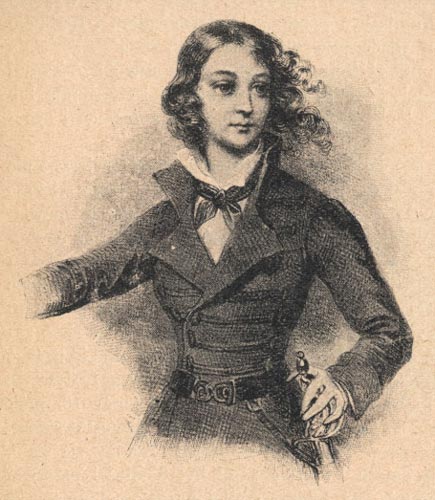
Born: November 13, 1806, Wilno, Russian partition of Polish-Lithuanian Commonwealth (presently Vilnius, Lithuania)
Died: December 23, 1831, Justianow, Russian partition of Polish-Lithuanian Commonwealth (presently ???)
The early days. Countess Emilia, daughter of Count Francis-Xavier Plater and Anna nee Mohl was born in Wilno (Vilnius) on the 13th November 1806. Most members of the Plater family were Polish patriots. Many contributed greatly to Polish culture. In 1815 Emilia’s parents separated and her mother took her to the estate of the relatives in Liksnie. Emilia read a lot, was very much interested in mathematics, wrote poetry, sang, drew, rode horses, hunted. As a young girl she was appalled by the lot of the peasants and endeavored to find out about their problems by mingling with them - learning about their habits and customs. She also collected and transcribed texts and tunes of folk songs. In 1823 she stayed in Dusiaty at her aunt Apolinara and with her sons Cezary and Wladyslaw studied the conditions of peasants’ life. At the same time she saw the plight of the Polish-Lithuanian Commonwealth under the heel of Russia and the suppression of freedom of speech and worship and of Polish customs and she wondered why her countrymen were not rising up to throw the oppressor out. She was very much influenced by courageous women such as Joan of Arc and tried to pattern her life on them.
Insurrection 1830. In 1831 the news of Warsaw Insurrection (November 1830) were received in Wilno. Although as a woman she was not allowed to participate in the meetings of the directing committee in Wilno she conceived the plan of capturing Dyneburg Fortress (presently Daugavpils in Latvia). She contacted two of her cousins, Lucjan and Ferdynand, pupils in local military college (“szkola podchorazych”) who promised that when the insurgents will approach Dyneburg, the pupils of the college will attack the crew of the fortress. On March 30 she fought an enemy horse patrol in the village Dangiele. On April 2 she forced an infantry company to retreat. On April 4 she fought a battle against General Shirman’s column who tried to reach main Russian forces at Dyneburg. The insurgent detachment took Jeziorosy, however the insurgents did not succeed in capturing Dynaburg by surprise.
Emilia and her cousins joined up with different sections of the insurrectionary army and Emilia, together with her cousin Cezary Plater, went to the detachment of the Wilkomierz Riflemen under Karol Zaluski and after that to Konstanty Parczewski's detachment of partisans.
After the arrival in Lithuania of General Dezydery Chlapowski, who organized the detachments into a regular army, Emilia was named Commander of the 1st Company of the 1st Lithuanian Regiment, known later as the 25th Infantry Regiment of the Line. She distinguished herself in the battles at Kowno and Szawle and was given the rank of Captain in the field. A.E. Odyniec has written about her "Your name in Polish and Lithuanian history will sound eternally as a song amidst the battle". When Chlapowski's force was split, she refused to make her escape with the columns heading for the Prussian border and decided to make her way to Warsaw with her cousin Cezary. In the course of this journey she became ill from exhaustion and was taken to a peasant’s cottage and then later to the mansion house of Ignacy Ablamowicz. In two letters from the 30th September 1831 addressed to one of her aunts, Emilia wrote words of farewell to her and other close relatives. She died at Justianow on the 23rd December 1831 and was buried in an unused cemetery at Kopciowa (presently Kapciamiestis), in a tomb which is still in existence today.
Emilia Plater remembered.
It is recorded in the Polish Dictionary of Biography that -
Her movable assets were confiscated by the Russian Government. Reports about her romantic involvement in the insurrection appeared in the Warsaw and Poznan press. In March 1832 there appeared the immensely popular poem by Mickiewicz "The Death of a Colonel" in which Emilia was stylized as an ideal commander, idolized by the soldiers and the people. In Paris, the Cirque Franconi presented her in the spectacular "The Poles of 1831" as though she was the new Joan of Arc.
Further publicity was given to her by her devoted cousins, Cezary and Ladislas. Joseph Straszewicz published three successive versions of her biography in French. Verse was dedicated to her in French, German, Italian, English and Hungarian by fellow-countrymen, Mickiewicz, Constantine Gaszynski and Antoni E. Odyniec. Widely disseminated lithographs by F. de Villain and Deveria popularized a conventional silhouette of a delicate, noble 'maiden'. Emilia was entered into the Pantheon of permanent independent heroes. In the 20th century there was dedicated to her a painting of Wojciech Kossak "Emilia Plater in combat with the Cossacks", a novel (1908) by Waclaw Gasiorowski, and a drama in three acts with an epilogue (1931) by Tadeusz Konczynski. In the period between the (two World) wars, the 22nd Infantry Regiment adopted the name of Emilia Plater. Her facsimile appeared on the 20 zloty banknotes of the Bank of Poland as well as on the Bank Issue of the Governor General. She was chosen as the patroness of the 1st Independent Battalion of Women and in the 1st Division named Tadeusz Kosciuszko. Even today, one of the central streets of Warsaw carries her name."
Even in Communist Poland, in 1959 a ship of 10,000 tons was built in the Gdansk shipyards for the Polish Oceanic Line and named the "M.S. Emilia Plater".
Based, with small changes, on the biography prepared by Mervyn B. de Plater from Brisbane, Australia. Permission given by the Plater family representative, Jan Broel-Plater, webmaster of
Platerowie
where the original is located.
See also other sources:
Harcerze
Suwalki
Jakub Bilski
Return to home page:
Prominent Poles